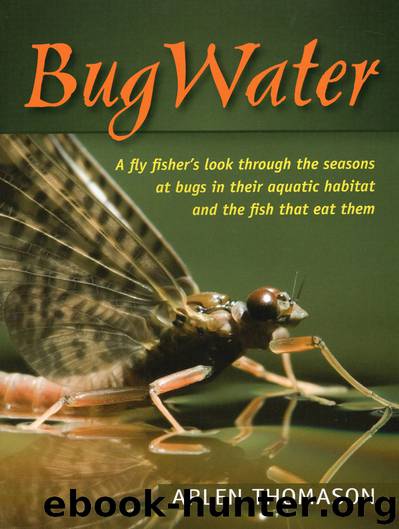BugWater by Arlen Thomason

Author:Arlen Thomason
Language: eng
Format: epub
ISBN: 9780811742603
Publisher: Stackpole Books
THE ADULTS
Adult golden stoneflies have about the same body lengths as mature nymphs, but they look larger. That is because when the wings are unfolded they extend another ⅓ inch or so rearward beyond the bug’s rump, and also expand laterally. The long tails and antennae also make it seem bigger than it really is. But even discounting those illusions, an adult golden stonefly is a substantial trout meal.
Like the nymphs, adults of the two western species of golden stoneflies differ somewhat in size and appearance. H. pacifica remains a little larger than C. californica. Color can vary; nevertheless in my experience, both have light brown wings and mostly brown dorsal surfaces, but the head and ventral surfaces of the former are more orange, compared with a more brownish-yellow color in those regions of the latter species. For a side-by-side visual comparison, I chilled some males and females of each species (to inhibit their tendency to walk off the photo set), and photographed both their dorsal and ventral aspects. (Sorry that they are not lined up in the same order in the two photographs; I must have needed some coffee that morning.)
Adults of both species may be found mingling together in some places, like these were when I collected them. As similar as they appear to us, they seem to be able to recognize members of their own species well enough. Otherwise we would have a bunch of mongrel stoneflies out there.
Just as for salmonflies, the first opportunity for a golden stonefly adult to enter a trout’s world is by losing its footing while clambering around overhanging vegetation. And the shorelines of a good golden stonefly river, like the Madison or the Deschutes, provide plenty of opportunity for clumsy stoneflies to fall in the water. The rocks and bushes often seem to be full of them at the peak of the hatch. Look around, and you’ll see something like a veritable birds-and-the-bees show-and-tell as the bugs get busy making the next generation.
Fertilized females take to the air late on warm summer afternoons, often in great swarms, with their eggs extruded into small packets at the rear of their abdomens. They fly out over the water, and dip to the surface repeatedly to brush off the eggs. Many of them end up in the drink, where they do not cope well. They ride very low, struggling and kicking and making a great fuss, as if oblivious to all the unhealthy attention they are drawing.
Download
This site does not store any files on its server. We only index and link to content provided by other sites. Please contact the content providers to delete copyright contents if any and email us, we'll remove relevant links or contents immediately.
Backpacker the Complete Guide to Backpacking by Backpacker Magazine(2193)
Capital in the Twenty-First Century by Thomas Piketty(1949)
The Isle of Mull by Terry Marsh(1899)
Predation ID Manual by Kurt Alt(1658)
The Collected Non-Fiction by George Orwell(1574)
Small-Bore Rifles by C. Rodney James(1505)
All Fishermen Are Liars by John Gierach(1447)
Backcountry Bear Basics by Dave Smith(1434)
Creative Confidence by Tom Kelley(1417)
The Art of Throwing by Amante P. Marinas Sr(1355)
50 Famous Firearms You've Got to Own by Rick Hacker(1342)
Blood Mountain by J.T. Warren(1304)
Archery: The Art of Repetition by Simon Needham(1303)
Long Distance Walking in Britain by Damian Hall(1280)
The Scouting Guide to Survival by The Boy Scouts of America(1252)
Backpacker Long Trails by Backpacker Magazine(1248)
The Fair Chase by Philip Dray(1226)
The Real Wolf by Ted B. Lyon & Will N. Graves(1212)
The Ultimate Guide to Home Butchering by Monte Burch(1205)
